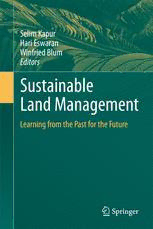
Sustainable Land Management: Learning from the Past for the Future PDF
Preview Sustainable Land Management: Learning from the Past for the Future
Sustainable Land Management . (cid:1) (cid:1) Selim Kapur Hari Eswaran W. E. H. Blum Editors Sustainable Land Management Learning from the Past for the Future Editors Dr.SelimKapur Dr.HariEswaran DepartmentofSoilScience& UnitedStatesDepartmentofAgriculture Archaeometry NaturalResourcesConservationService UniversityofC¸ukurova POBox2890 01330Adana,Turkey Washington,DC,USA [email protected] [email protected] Dr.WinfriedE.H.Blum InstituteofSoilResearch DepartmentofForestandSoilSciences UniversityofNaturalResources andAppliedLifeSciences(BOKU) Vienna,Austria [email protected];[email protected] ISBN978-3-642-14781-4 e-ISBN978-3-642-14782-1 DOI10.1007/978-3-642-14782-1 SpringerHeidelbergDordrechtLondonNewYork LibraryofCongressControlNumber:2010938610 #Springer-VerlagBerlinHeidelberg2011 Thisworkissubjecttocopyright.Allrightsarereserved,whetherthewholeorpartofthematerialis concerned,specificallytherightsoftranslation,reprinting,reuseofillustrations,recitation,broadcasting, reproductiononmicrofilmorinanyotherway,andstorageindatabanks.Duplicationofthispublication orpartsthereofispermittedonlyundertheprovisionsoftheGermanCopyrightLawofSeptember9, 1965,initscurrentversion,andpermissionforusemustalwaysbeobtainedfromSpringer.Violations areliabletoprosecutionundertheGermanCopyrightLaw. Theuseofgeneraldescriptivenames,registerednames,trademarks,etc.inthispublicationdoesnotimply, evenintheabsenceofaspecificstatement,thatsuchnamesareexemptfromtherelevantprotectivelaws andregulationsandthereforefreeforgeneraluse. Coverdesign:deblik,Berlin Printedonacid-freepaper SpringerispartofSpringerScience+BusinessMedia(www.springer.com) Dedicated to the Dear Memory of Prof. Dr. Cemil Cangir (1946–2010) Cemil Cangir the warrior of soil protection in Thrace, Turkey, passed away suddenly in Tekirdag˘ on May 10th 2010, at the age of 64, now lying in a village cemetary,whomhesoughttobeburiedasasiteoverlookingtheviewofthesoils whichhededicatedhislifeinsearchofhisuniqueprotectionstrategies.Theever- threatened fertile soils of Thrace by the inappropriate growth of the industry and urbanisationarenowseekingforthedecendantsofthe“CangirSchool”totakeover the task and proceed the fight for their protection. The incomparable community and NGO solidarity Cemil had achieved as his life-long dream was based on a simplekey,namelythe“IntegratedSustainableBasinManagementoftheland”. SelimKapurandKorayHaktanır . Preface Inappropriateuseoflandandwaterisstillon-going,despitealleffortsundertaken bynumerousinstitutionsdealingwithlandandsoilprotection,asforexamplethe European Soil Protection Strategy, aiming at a common legal instrument for soil protectioninEurope. One of the failures lies in conceptual problems, because the protection of land andwaterhavetobedoneatriverbasinscale. The“Anthroscape”-approachpresentedinthisbookisthoughtasacontribution toimprovethesustainablemanagementoflandandwateratriverbasinscale,based on an analysis of the past developments, in order to shape the contemporary and futureuseoflandinasustainableway. Moreover, this book contains information about traditional techniques and knowledge,shownatspecificexamplesofthe“Anthroscapes”,whichweredevel- opedbyanintegratedmanagement,withaholisticperspective,tomeettheneedsof humansinalandscape,likewater,food,biodiversityandculture. Therefore,thetitleofthisbookis“SustainableLandManagement:Learning fromthePastfortheFuture”. Eachchapterofthebookhasbeendiscussedonseveraloccasionsinthefieldas well as during international conferences and meetings related to the topic of “Anthroscapedevelopment”.Moreover,thechapterswerearrangedinsuchaway that they are complimentary, regarding specific aspects of the “Anthroscape” concept. Chapter 1 introduces into the book, describing the key components of sustain- able land and water management at river basin scale, which was specifically developedbyH.Eswaranwhohasdevotedthemanyeffortstodevelopaconceptual frameworkonthebasisofhislong-standingandworldwideexperienceonsoilsand landscapes. Chapter 2 is mainly designated to the recent development of the EU SoilThematicStrategy.Chapter3reflectsthemajorbenefitofstudiesofland/soilat riverbasinscale,disregardingfrontiersandregions.Chapter4describesthemajor soilsofMediterraneanAnthroscapes,withspecialreferenceonrenovatedtradition- allandusetechniquesintheApuliaregionofsouthernItaly.Chapter5discussesthe . vii viii Preface presently observed side-effects of touristic activities in the Italian Alps, including major threats to European water sources. Chapter 6 deals with North European Anthroscapes, and negative impacts, by measures within a particular region in SouthEastNorway.Chapter7describesanexpensiveandtimeconsumingpractice, partiallydiscussedverycontroversially,intheuseofcontemporarytechnology,for usingsoilswithcalcrete(petrocalcic)horizonsinSardinia,Italy,forincreasingthe productivity of vineyards. Chapter 8 deals with the use of soils on mine waste deposits in southeast Spain and Chap. 9 describes important Asian Anthroscapes, createdbyanthropogenicactivitiesduringthousandsofyears,forthecultivationof rice. In Chap. 10, Anthroscapes from Morocco were described, under the aspect of the use of exotic plants to rehabilitate degraded rangeland and to mitigate desertification. Chapter 11 deals with anthropogenically re-shaped land and its historical and culturalbackgroundintheAdanaregioninTurkey. Chapter12explainstheimpactoftheancientpracticeofshiftingagricultureto the forestecosystem and the low-input agricultural system to the Anthroscapesin Sarawak, Malaysia and Chap. 13 refers to impacts by improper land use in the Mediterraneanarea,andespeciallyattemptstore-useabandonedmininglandscapes inMurcia,southernSpain.Chapter14dealswithpossiblefutureimpactsofclimate change on Mediterranean coastal areas, including the Anthroscape in Adana, Turkey. InChap. 15field trials for theevaluation ofindigenous techniquesfor soiland water conservation in Niger (Africa) were discussed, searching less costly and labor-intensiveconservationtechniques. Similarly, Chap. 16 deals with local knowledge in protecting landscapes in Japan,withspecialattentiontotheculturalbackgroundandwisdomoftheeco-life. Chapter 17 is very specific and deals with an experimental study, aiming to recoverancientnaturallandscapesintheAdanaregion,reconstructinglostpartsof thelandscapeandregeneratingbiodiversity. Economicandsocialproblemsindegradedlandscapes,includingtheevaluation ofthecostsoflanddegradationarediscussedinChap.18. We specially thank the everlasting encouragement and patience of Drs. Hans Guenther Brauch and Christian Witschel, from Springer Editors. Our thanks are alsoduetoDr.IsmailC¸elik,Dr.E.Akc¸a,Dr.KemalGu¨lu¨t,Dr.M.DingilandMr. K.Y.Kocafortheirsupportineditingthisbook. Wefinallyexpressoursinceregratitudetoalltheauthorsofthisbook. Adana,Turkey SelimKapur HariEswaran WinfriedE.H.Blum Contents TheAnthroscapeApproachinSustainableLandUse ....................... 1 H.Eswaran,S.Berberog˘lu,C.Cangir,D.Boyraz,C.Zucca, E.O¨zevren,E.Yazıcı,P.Zdruli,M.Dingil,C.Do¨nmez,E.Akc¸a, I.C¸elik,T.Watanabe,Y.K.Koca,L.Montanarella,M.Cherlet,andS.Kapur AnthroscapesintheLightoftheEUSoilThematicStrategy ............. 51 LucaMontanarella SoilErosion-DesertificationandtheMiddle EasternAnthroscapes ......................................................... 57 UrielN.Safriel,PedroBerliner,ArielNovoplansky, JonathanB.Laronne,ArnonKarnieli,ItzhakMoshe, A.Kharabsheh,A.GhalebMohammad,andG.Kusek SoilsoftheMediterraneanRegion,TheirCharacteristics, ManagementandSustainableUse .......................................... 125 PandiZdruli,SelimKapur,andIsmailC¸elik MountainAnthroscapes,theCaseoftheItalianAlps ..................... 143 FrancoPrevitali DevelopmentandChallengesoftheAnthroscapesintheClay SoilDistrictofEasternNorway ............................................. 163 ArnoldArnoldussen AnthroscapesandAnthropogenicSoilsinNorth-WesternSardinia: TheSoilswithCalcreteHorizonintheAlgheroArea(Italy) ............. 179 S.MadrauandC.Zucca StimulatedSoilFormationinaDegradedAnthroscape: ACaseStudyinSoutheastSpain ........................................... 193 J.M.Arocena,J.M.vanMourik,andA´.FazCano ix x Contents AsianAnthroscapes:ChinaandTaiwan ................................... 205 Zeng-YeiHseu,Chen-ChiTsai,HengTsai,Zueng-SangChen, andHariEswaran AnAnthroscapefromMorocco:DegradedRangelandSystems andIntroductionofExoticPlantMaterialandTechnology .............. 243 C.Zucca,F.Previtali,S.Madrau,E.Akc¸a,andS.Kapur TheHistoricalAnthroscapeofAdanaandtheFertileLands ............ 259 NurettinC¸elmeog˘lu ImpactofShiftingAgricultureontheSustainability ofAnthroscapesinSarawak,Malaysia ..................................... 285 E.PadmanabhanandH.Eswaran RomanMiningLandscapesintheMurciaRegion, SESpain:RiskAssessmentofMinePonds ................................. 293 A.FazCano,A.Zanuzzi,P.Martinez-Pagan,J.Acosta, D.Carmona, S.Martinez-Martinez,andM.Mun˜oz AnthroscapeoftheMediterraneanCoastalAreaintheContext ofHydrogeology:ProjectedImpactsofClimateChange ................. 311 KatsuyukiFujinawa Re-evaluatingIndigenousTechnologiesforSustainableSoil andWaterManagementintheSahel:ACaseStudyfromNiger ........ 333 TakanoriNagano,HaruhikoHorino,andTakashiKume LocalWisdomofLandandWaterManagement: TheFundamentalAnthroscapeofJapan ................................... 351 TsugihiroWatanabe ReconstructingthePastbyRegeneratingBiodiversity: ATreatiseonWeedContributiontoSoilQuality ataPost-cultivationSuccession ............................................. 363 I.C¸elik,K.T.Yilmaz,H.Eswaran,A.Mermut,M.Dingil,Z.Kaya, A.Demirbas¸,I.Aksit,I.Ortas¸,M.Go¨k,C.Akpınar,T.Nagano,N.Ae, Y.K.Koca,andS.Kapur EconomicandSocialImpactoftheDegradedAntroscapes .............. 379 NejatErk Index .......................................................................... 411
